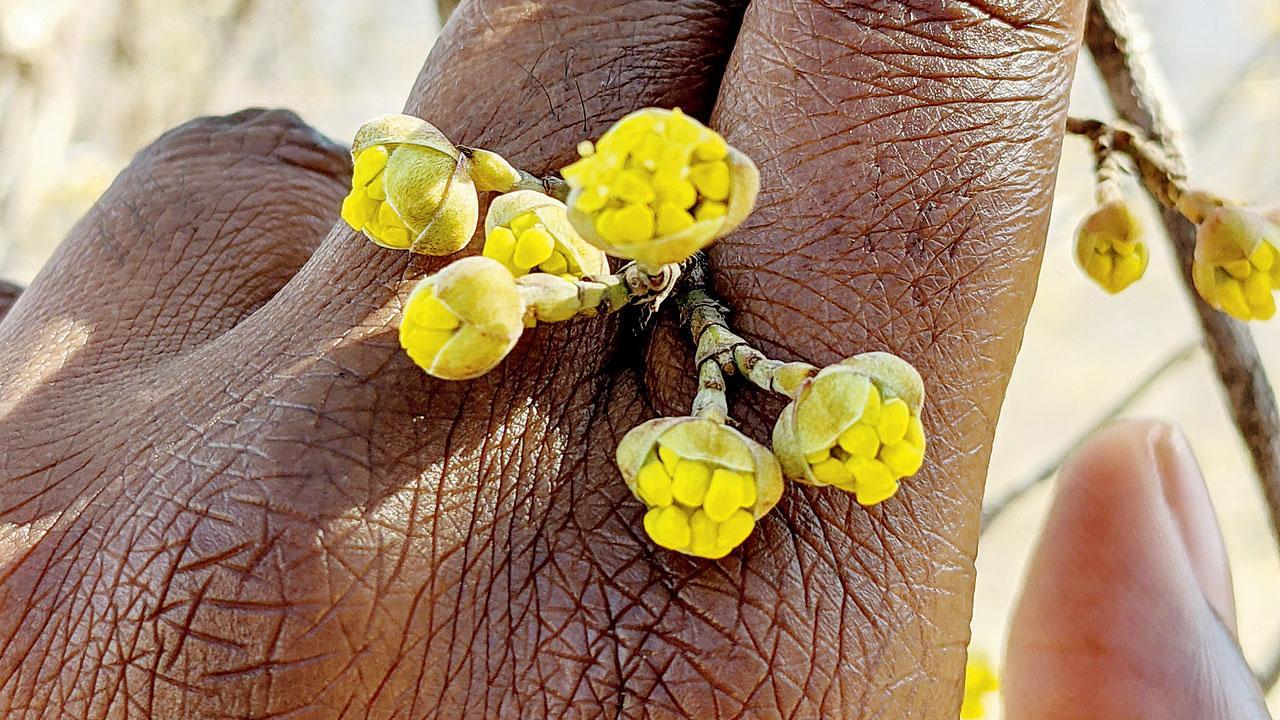The monotone colours of winter are gone, the vegetation on the snow-irrigated land is bursting with life, and I am fortunate enough to be here to witness and feel a oneness with this force of nature

I was astonished to find that the plum-red fruit known in English as Cornelian cherry emerges from a flush of bright golden-yellow florets. Pic/Rosalyn D’Mello
Towards the final week of February, I heard the sound and caught a glimpse of the church caretaker (the Messner), a pious East-German man, clearing the dried fallen leaves that had carpeted the premises.
With each swish of his broom, it seemed like winter was being erased. I saw a giant transparent plastic bag stuffed with the remains. The two vestigial blocks of piled ice near the entrance to the church had melted away, too.
ADVERTISEMENT
Snow seemed like a distant memory and I finally grasped its ephemerality. My tongue still bore traces of the taste of collected flakes. My memory of its flavour is intertwined with the accompanying scents of burning wood and incense. Once the Messner was done, the earth was visible once more, as were the light tufts of grass that were already emerging. It felt as though his administrations were responsible for a seasonal shift, for soon after, spring began to announce itself more fervently.
The whorled nodes I had seen on the ends of leafless tree branches seemed desperate to unfurl. Because I have never before inhabited a landscape in which I have experienced the total shedding of trees, this springtime feels like a first. In summer, I had got acquainted with the foliage to the point where I could look at a tree and identify it. The absence of leaves affected my ability to tell which was which, beyond the obvious.
As the year repeats itself, I’m privileged to be present to see what the blossoms of fruits I know look like, how they appear to burst forth. The hazelnut tree, for instance, is in bloom, and the yellow flowers hang in inch-long trails from the branches, like luminous jewels.
I was astonished to find that the plum-red fruit known in English as Cornelian cherry, in fact, emerges from a flush of bright golden-yellow florets. I have been photographing them obsessively, to remind myself of their origin story when my partner’s aunts will eventually gift us a cordial they make from the fruit. Last year I had tasted loquat or Japanese Mispel for the first time and was surprised by the interplay of sweet and sour textures. The tree arranges the flowers in bunches, similar to how the yellow fruit will eventually be formed.
Last week my partner took me to Frühlingstal, which literally translates to Spring Valley. It’s nestled in the middle of a short mountain chain within the Etsch valley. He told me that through the rest of the year the terrain seems fairly ordinary, however, in early spring, it becomes a spectacle. I was amazed to find whole swathes of white flowers that bow towards the ground, as if in prayer. The local name for them translates to little snow bells. They look like their name and were ubiquitous, occasionally contrasting against the purple of another bloom.
After the monotone of snow, colours seem all the more resplendent. When we go on our daily walks I have to pause every now and then at the sight of grass growing at the base of the vineyards which offers a green undertone to my vision. My father-in-law recently planted 1,000 tulips in the garden of the winery in which we live. I cannot imagine yet how they will appear when they bloom. I cannot imagine yet the colours the waxy petals will assume.
The blood beech tree stationed exactly in front of my window, within the church premises, whose leaves the Messner had swept away, is also slowly preparing for its metamorphosis. When the new copper-red leaves emerge and assume density, I will lose my view of the two snow-capped mountains on the immediate horizon. I had come to depend upon their rosy glow during the sunset hour. It always felt like an event. The last full moon also rose from that direction.
I’ve been thinking a lot about what it means to witness all of this. To encounter spring as a gradual procession, a slow stirring of colours, a seamless elongation of daylight, and what it might mean to ‘have’ time. I find I am fuelled by daily doses of hope, not in a way that feels external, but through the internalising of the sight of all of this bounty and beauty. To somehow grasp that the matter that constitutes my body is not dissimilar from that which I confront, to feel a oneness with the blossoms, with snow-irrigated soil, with the cross-pollinating bees, and the wild scent of moist leaves, is to glean a kinship with divinity.
Deliberating on the life and times of Everywoman, Rosalyn D’Mello is a reputable art critic and the author of A Handbook For My Lover. She tweets @RosaParx. Send your feedback to mailbag@mid-day.com
The views expressed in this column are the individual’s and don’t represent those of the paper.
 Subscribe today by clicking the link and stay updated with the latest news!" Click here!
Subscribe today by clicking the link and stay updated with the latest news!" Click here!







